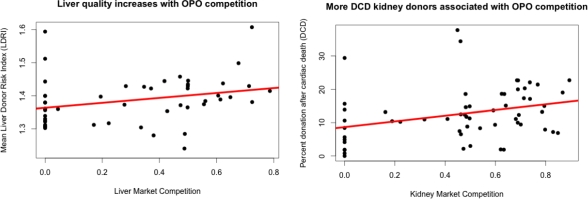Does DSA Market Competition Influence OPO Performance?
1Surgery, Massachusetts General Hospital, Boston, MA
2Surgery, Brigham and Women's Hospital, Boston, MA
3Surgery, Dartmouth Hitchcock Medical Center, Lebanon, NH.
Meeting: 2015 American Transplant Congress
Abstract number: 84
Keywords: Allocation, Donation, Economics
Session Information
Session Name: Concurrent Session: Economics, Policy and Ethics
Session Type: Concurrent Session
Date: Sunday, May 3, 2015
Session Time: 4:00pm-5:30pm
 Presentation Time: 4:12pm-4:24pm
Presentation Time: 4:12pm-4:24pm
Location: Room 118-C
INTRODUCTION: Increased market competition within a Donor Service Area (DSA) is associated with a greater number of liver and kidney transplants, but its effect on Organ Procurement Organization (OPO) performance is unknown. We therefore investigated the relationship between competition and Organ Procurement Organization (OPO) performance.
METHODS: The Scientific Registry of Transplant Recipients from 2002 to 2011 was queried for organ donors, number of transplants, DCD kidneys, import:export ratios (marker of need), and Standardized Donor Ratios (SDR). The Herfindahl Hirschman Index (HHI), a standard measure of market competition, was applied to each DSA. Kidney Donor Risk Index (KDRI) and Liver Donor Risk Index (LDRI) were used for organ quality. Hierarchical linear mixed effects models were created between DSA competition and these metrics. Finally, a measure of underutilized livers was created by quantifying the number of non-used livers at different HHI with respect to the mean LDRI at a given HHI.
RESULTS: Adjusted for population, the number of organ donors and transplants increased with more competition (kidney P<0.001, liver P<0.001). Higher competition was associated with increased LDRI (P=0.03, Figure), use of DCD kidneys (P=0.02, Figure), livers per kidney donor (P=0.04), and import:export ratios for kidney (P=0.01) and liver (P=0.04). SDR did not correlate with either kidney or liver competition. More competitive DSAs utilized more livers below the mean LDRI in comparison to less competitive DSAs (P<0.001).

CONCLUSIONS: More competitive DSAs were associated with better OPO performance and increased organ utilization, suggesting that OPOs may also be influenced by competition within a DSA. This was particularly true for liver transplantation, where the additional utilization of low LDRI livers was approximately 6%. Because less competitive DSAs underutilize organs, market competition and OPO performance could be optimized under broader organ distribution to increase utilization and supply.
To cite this abstract in AMA style:
Adler J, Yeh H, Markmann J, Nguyen L, Axelrod D. Does DSA Market Competition Influence OPO Performance? [abstract]. Am J Transplant. 2015; 15 (suppl 3). https://atcmeetingabstracts.com/abstract/does-dsa-market-competition-influence-opo-performance/. Accessed December 14, 2025.« Back to 2015 American Transplant Congress
